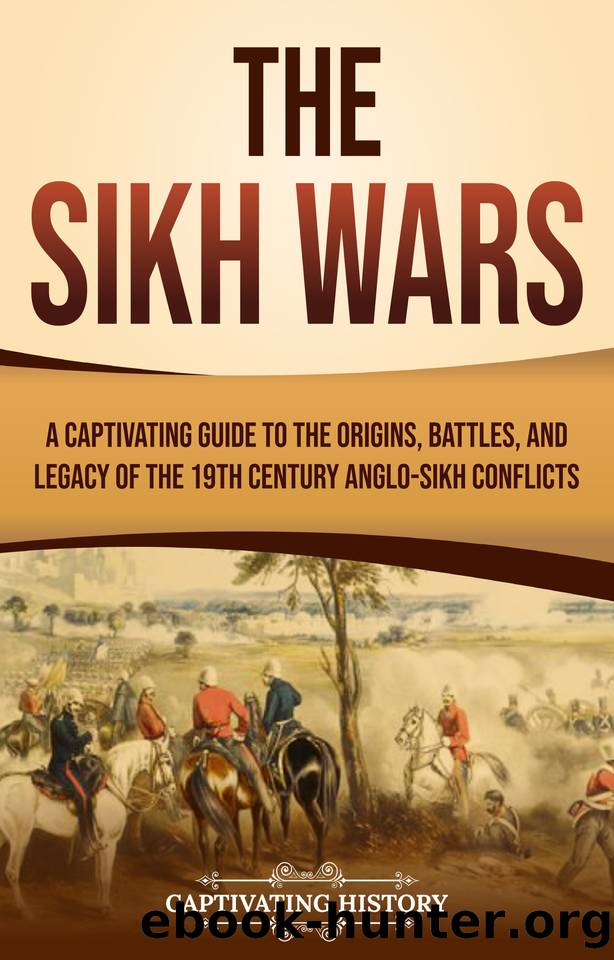The Sikh Wars: A Captivating Guide to the Origins, Battles, and Legacy of the 19th-Century Anglo-Sikh Conflicts (Exploring Indiaâs Past) by History Captivating

Author:History, Captivating
Language: eng
Format: epub
Published: 2024-02-05T00:00:00+00:00
Chapter 5 â The First Anglo-Sikh War 1845-46
The First Anglo-Sikh War was quite brief, lasting less than a hundred days, from December 4th, 1845, to March 9th, 1846. There were four main battles: Mudki, Ferozeshah, Aliwal, and Sobraon. The last one decided the war. The British prevailed on the battlefield, but British military strength was not the only factor. There are serious allegations of treachery on the part of important Sikh commanders. One or more Sikh defeats might have been facilitated or even planned by other Sikhs.
An aspect of most of the battles was the Sikh forces constructing a defensive position with trenches, parapets, and anti-cavalry devices like cheval de frise (sharp spikes). This was a recognition that the British were substantially better at tactical maneuvers on the battlefield.[50]
The personalities of the commanders of both sides were important in this war. Lal Singh was an administrator, not a soldier, although he did command an army when he negotiated with Gulab Singh in Jammu. His loyalty to the maharaja appeared to have been strong, but his loyalty to the army itself was questionable.
Another important Sikh commander in this war was Tej Singh (1799â1862). Tej was a protégé of Nao Nihal Singh and became a general at the age of nineteen. Following the death of Nao Nihal, he at first supported Chand Kaur as regent and then, after her murder, supported Jind Kaur as regent. She made him commander, probably in return for his support.
Tej was a good commander and had considerable military experience. He converted to Sikhism in 1816, being born into a Hindu Brahmin family. He aided the British in the fighting in Afghanistan in 1839 and was friendly with them. Tej was commander in chief of the army when the First Anglo-Sikh War broke out and reportedly was very reluctant to follow the maharaniâs order to cross the Sutlej and invade British India. Tej Singh and Lal Singh might not have had the armyâs best interests at heart.
The two most important British commanders were Sir Hugh Gough from Ireland (1779â1869), the commander in chief of the British forces in India, and Sir Henry Hardinge from England (1785â1856), the governor general of British India from 1844 to 1848.
Gough participated in British wars on five continents. He was involved in the capture of Cape Colony from the Dutch in South Africa, against the French in the West Indies, in capturing Suriname in South America, and in the Peninsular War against Napoleon in Spain. Gough commanded the British forces in the First Opium War in China and commanded in both Sikh wars. He was knighted for his accomplishments in Spain. His long run of victories eventually resulted in him being knighted. He was made a baron, then a viscount, and ended as a field marshal. Oddly, for more than a decade, Gough was out of the military loop, retiring on half pay to his estate in Ireland.[51]
While Gough was commander in chief of the forces in India, it did not actually mean he commanded all of India.
Download
This site does not store any files on its server. We only index and link to content provided by other sites. Please contact the content providers to delete copyright contents if any and email us, we'll remove relevant links or contents immediately.
| Confucianism | Feng Shui |
| I Ching | Jainism |
| Karma | Shintoism |
| Sikhism | Tao Te Ching |
| Taoism | Tibetan Book of the Dead |
| Zoroastrianism |
The Tao of Physics by Fritjof Capra(2231)
Human Design by Chetan Parkyn(2032)
The Diamond Cutter by Geshe Michael Roach(2022)
Feng Shui by Stephen Skinner(1903)
The Alchemy of Sexual Energy by Mantak Chia(1818)
Tao Te Ching by Lao Tzu(1806)
365 Tao: Daily Meditations by Ming-Dao Deng(1590)
Tao Tantric Arts for Women by Minke de Vos(1549)
Sun Tzu's The Art of War by Giles Lionel Minford John Tzu Sun(1505)
Sidney Sheldon (1982) Master Of The Game by Sidney Sheldon(1475)
Buddhism 101 by Arnie Kozak(1473)
Karma-Yoga and Bhakti-Yoga by Swami Vivekananda(1470)
The Analects of Confucius by Burton Watson(1396)
The Art of War Other Classics of Eastern Philosophy by Sun Tzu Lao-Tzu Confucius Mencius(1378)
Tao te ching by Lao Tzu(1332)
The Way of Chuang Tzu by Thomas Merton(1328)
The New Bohemians Handbook by Justina Blakeney(1322)
The Sayings Of by Confucius(1283)
Bless This House by Donna Henes(1237)
